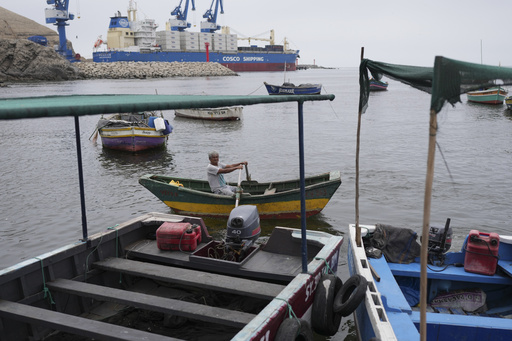
LIMA, Peru — Last week could have turned out differently for U.S. President Joe Biden as he headed to the Asia-Pacific Economic Cooperation (APEC) summit in Peru. Instead, circumstances have shifted dramatically, diminishing the chance for him to portray confidence and enthusiasm for collaboration with Latin American nations. Currently, those aspirations appear out of reach as the political landscape evolves.
Mirroring the situation in 2016, when Lima last hosted APEC, Biden faces challenges following Donald Trump’s recent electoral success. Experts note that the anticipated return of Trump’s “America First” policy complicates Biden’s efforts to elevate the U.S. standing during his inaugural presidential visit to South America. Consequently, China, led by Xi Jinping, is poised to capture attention in a region traditionally influenced by the United States.
One of Xi’s main initiatives during his official visit is the unveiling of a $1.3 billion megaport, a project that starkly showcases China’s expanding presence in the area. Over the next ten years, total investments are projected to exceed $3.5 billion. “This isn’t how the U.S. envisioned engaging at this summit,” stated Margaret Myers, who oversees the China and Latin America program at a Washington-based policy institute. She further remarked that all eyes will be on Xi and the significance he attributes to this port regarding relations across the Pacific.
With the U.S. seemingly leaning towards a more isolationist stance under Trump, there is a growing perception that China may assume a more favorable role in the region. The Chancay megaport, located approximately 60 kilometers from Lima, epitomizes this shift in Latin America’s economic dynamics. Chinese shipping tycoon Cosco now owns a 60% interest in this venture, which it developed in collaboration with the Peruvian firm Volcan.
Peruvian Foreign Minister Elmer Schialer emphasized the implications of this port for regional commerce, suggesting it will revolutionize logistics along the entire Pacific coastline, spanning from North America to South America. He pointed out that neighboring countries like Brazil, Colombia, and Chile are actively modifying their supply chains to take advantage of this strategic port, which could reduce shipping times to Beijing by up to ten days.
Trade between China and Latin America has seen exponential growth, expanding 35 times from the year 2000 to 2022, as indicated by the Economic Commission for Latin America and the Caribbean. Most of the exports from this region originate from South American countries, with major products including soybeans, copper, oil, and iron ore.
In addition to trade, Xi has made notable advances in diplomacy within Latin America, visiting 11 countries since assuming the presidency. This month, he is honored with a full state visit in Brazil and Peru, a privilege that Biden will not receive. Some analysts see the perception that nations in the region must choose between two large trading partners as a significant setback for U.S. interests.
As Eric Farnsworth from the Council of the Americas articulated, there is a notable shift in sentiment: “The region is increasingly hearing that China might be the better partner, and Xi is aiming to reinforce this viewpoint.”
Although some anticipate that China’s massive loans through initiatives like the Belt and Road Initiative may not be forthcoming as they were a decade ago, opportunities for collaboration in sectors such as renewable energy and telecommunications remain plausible. Meanwhile, the U.S. continues to express concern over Chinese investments in telecommunications, specifically opposing companies like Huawei, which it claims pose risks of espionage. U.S. officials have similarly raised alarms regarding the Chancay port’s potential dual-use for military purposes, though Chinese representatives have refuted those claims.
U.S. Defense Secretary Lloyd Austin recently asserted that China is attempting to capitalize on vulnerabilities in Latin America, using the need for investment to further its strategic agenda. Despite these concerns, many experts argue that the U.S. lacks the capability or sincerity to match China’s infrastructure developments.
Even when opportunities arise for American companies to engage competitively in significant infrastructure projects in Latin America, they have generally steered clear, according to Benjamin Gedan from the Wilson Center. While a Democratic administration could have better positioned Biden to discuss future U.S. commitments, recent political developments may undermine those prospects.
Differing sharply from Biden’s approach to fostering alliances, Trump has articulated a plan to protect U.S. interests, pledging continued unilateral action characteristic of his previous administration, which often featured antagonistic policies toward foreign competition and increased tensions with China.
In response to these developments, Biden initiated the Indo-Pacific Economic Framework as a means to bolster regional economic integration and counterbalance China’s influence. However, Trump has expressed intentions to dismantle this agreement should he reclaim the presidency, echoing his decision to withdraw from the Trans-Pacific Partnership shortly after taking office in 2017.
As U.S. influence appears to wane in South America and China’s foothold continues to strengthen, analysts foresee that competition between the two powers will dominate discussions during the APEC summit this week.
“China revels in the opportunity to outmaneuver the U.S. in its neighboring regions,” noted Gedan, commenting on the dynamics surrounding Xi’s visit and the significant infrastructure developments taking place.
